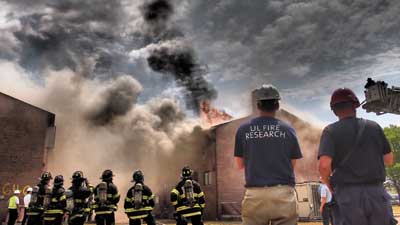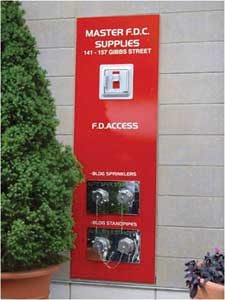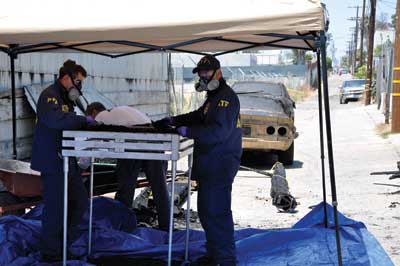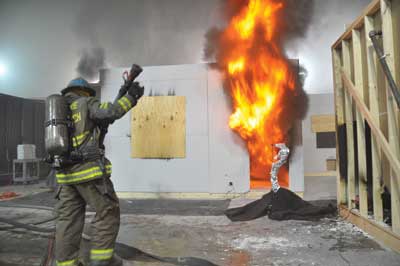BY THOMAS PLATT
Over the past few decades, the fire service and its scope have undergone an evolution. Unprece-dented new hazards and threats have emerged. Fires are burning differently because of modern construction techniques and furnishings; budget constraints are limiting staffing, equipment purchasing, and training; and firefighters now face not only new hazardous materials and technical rescue challenges but also terrorist and criminal events. Upholding the fire service mantra “adapt and overcome,” we have responded proactively to these challenges by expanding our capabilities and introducing new technology, equipment, and training. To assist in fully understanding these ever-changing issues, fire protection engineers (FPEs) have provided valuable technical expertise to the fire service’s progression. By hiring an FPE, a fire department will benefit greatly, as outlined below.
 |
| (1) Fire protection engineers from Underwriters Laboratories (UL) and the National Institute of Standards and Technology (NIST) work with Fire Department of New York personnel to study fire behavior in real-world controlled experiments to validate various firefighting tactics. http://bcove.me/lgd2xbyy (Photo and video by the UL Firefighter Safety Research Institute.) |
Fire protection engineering uses science and technology to protect people, properties, and businesses from destructive fires. FPEs understand how buildings are used; how fires start; how fires grow; and how fire and smoke affect people, buildings, and property. Using the latest technologies, they design systems that control fires and smoke, alert people to danger, and provide the means for escape; they evaluate buildings to pinpoint the fire risks and mitigate them; they conduct fire safety research on firefighting tactics and equipment, consumer products, and construction materials; and they investigate fires to discover how fire originates and spreads, why protective measures fail, and how those measures could have been designed more effectively. Although many FPEs work in the consulting, design, or insurance industries, their roles within the fire service are increasing, offering additional technical expertise and capabilities.
BUILDING FIRE PROTECTION
Fire protection is a comprehensive strategy that extends well beyond fixed systems or fire department operations alone. It is achieved by analyzing hazards and occupancies, installing appropriate fire protection systems, integrating them with other building systems, and coordinating these systems with the human interface during occupant evacuation and fire department operations.1
 |
| (2) The keybox, fire department connections, and building address are located conspicuously for easy identification. (Photo by Mat Chibarro, Occupational Safety and Health Administration.) |
Design coordination by an FPE can ensure that fire protection systems are appropriate for the building and its jurisdiction, that all systems operate and are integrated in accordance with the overall fire protection strategy and design, and that these systems’ necessary interfaces are coordinated with the fire department and are user friendly. This may include, but is not limited to, standpipe system design, hydrant and fire department connection placement, understandable fire alarm annunciators, elevator recall sequencing and automated unlocking of entry/egress doors, shutdown of heating-ventilation-air-conditioning (HVAC) units, and activation of smoke control systems. FPEs understand that there is no time to compensate for illogical design when the fire department is arriving on a working incident.
FPEs verify the fire protection strategy after design by overseeing and inspecting construction and installation. The FPE ensures that the installation complies with the designs and standards, meets all codes and regulations, and is coordinated with other building systems. Since engineering methodology often establishes codes and standards, the FPE can interpret and justify code requirements in-house through technical analysis and can evaluate the underlying methodology when contention arises (e.g., when establishing new local requirements or when reviewing performance-based designs that deviate from prescriptive requirements).
Pulling the overall strategy together then requires integrated testing during which the FPE can verify that all systems interact as intended and can provide training to the department personnel on the necessary interfaces to ensure understanding and effective operations.
EMERGENCY MANAGEMENT
The fire protection strategy is based on analyzing a structure’s internal fire hazards and external fire exposure, exposure to natural hazards, and an understanding of the public utility infrastructure available to them, such as the water supply or the electrical feed. Since these are all essential factors in emergency management, contingency planning, and emergency response, the FPE can be a valuable resource to the emergency management team and incident command system before, during, and after an incident.
All of the fire department training and proficiency for response will be ineffective if responders don’t know of certain building features, the presence of hazardous materials, the water supply, or the vehicle access points. FPEs can assist with building and community preplanning and emergency response because of their knowledge of the community’s target fire hazards, the effects of flooding on vehicular evacuation and fire department access, and redundant water supply sources in the event of a break.
 |
| (3) Bureau of Alcohol, Tobacco, Firearms and Explosives (ATF) fire protection engineers assist investigators with post-fire analysis. (Photo by ATF Fire Research Laboratory.) |
FIRE INVESTIGATION
Following a fire event, FPEs often work hand-in-hand with fire investigators to support investigations by performing engineering analysis and fire modeling to test the hypothesis of the investigator.2 Their expertise is routinely used in the courtroom for support during a litigation. Many of the postincident reports and firefighting training material provided by the U.S. Bureau of Alcohol, Tobacco, Firearms and Explosives (ATF); the National Institute of Standards and Technology (NIST); and Underwriters Laboratories (UL) are based on the investigation, analysis, and experimentation FPEs have conducted. These engineers have also provided much of the experimental data found in National Fire Protection Association 921, Guide for Fire and Explosion Investigations, which is used in quantifying fire characteristics during an investigation. (2)
TRAINING AND RESEARCH
The FPE’s background in fire protection systems, fire dynamics, and structural behavior can also be a valuable training resource for fire department personnel and the community. Fire department personnel can learn more about building fire protection systems as they are being installed, witness testing and acceptance, and understand the user interfaces prior to an incident response. The FPE can ensure these components are designed for the firefighters using them and orient the firefighters to their functionality and design intent. Conversely, firefighters may also offer their recommendations directly to the FPE to ensure their needs are met.
By sharing new experimental data from fire research, the FPE can both educate others on fire behavior and diffuse common misconceptions. Fire protection engineering researchers have provided the industry with a multitude of training resources addressing fire dynamics; the effects of fireground tactics; and the performance characteristics of tools, clothing, and equipment. Full-scale experimentation has demonstrated the effects of various firefighting tactics and operations, some of which justify and reinforce decades-old “traditional” tactics, whereas others promote the use of modern technology.
As demonstrated by fire researchers at UL and NIST, for example, FPE-led fire experiments allow the fire service to understand changes in residential fire dynamics resulting from construction materials, building layout, contents, furnishings, and other factors. These experiments have provided insight into effects on operational time frames, such as available safe egress time for occupants, time to flashover, and time to collapse, which can better prepare and protect our own as well as the community.3
 |
| (4) ATF fire protection engineers conduct fire experiments to recreate fire scenes and identify fire dynamics characteristics to assist with investigations. (Photo by ATF Fire Research Laboratory.) |
Locally, the FPE can bring home the work of these researchers through presentations, computer modeling, and scaled fire demonstrations. Through fire department training, the FPE can demystify topics such as flashover, smoke behavior, and fire protection system operations to provide a better understanding to firefighters. In the community, the FPE can enhance the public’s perception of fire safety and fire protection systems, particularly with regard to residential smoke alarms and the heated battle over residential sprinkler legislation.
QUALIFICATIONS
The market for fire service-based FPEs is growing and becoming increasingly beneficial. FPEs often have a bachelor’s degree and possibly even a master’s degree in engineering, many specifically in fire protection. The advanced mathematics, science, and engineering courses, combined with the practical hands-on experience these programs offer (and any firsthand firefighting experience), provide the FPE with the technical and problem-solving skills necessary to understand the complexities of fire and the means to protect against it. The combination of these skills allows for objective engineering analysis of situations and corresponding solutions to safeguard the general public and the fire service that protects it.
In the United States, licensure as a professional engineer (PE) supplements educational qualifications and includes an evaluation of education, engineering experience and the passing of two rigorous examinations. FPEs are tested on their comprehensive understanding of general engineering topics, fire protection analysis, fire protection management, fire science and human behavior, fire protection systems, and passive building systems.4
For more information on hiring a fire protection engineer, as well as a sample job description, visit http://www.sfpe.org > About Us > Committees & Task Groups > Fire Service Committee.
Endnotes
1. United States Occupational Safety and Health Administration (2006), Fire Service Features of Buildings and Fire Protection Systems, www.osha.gov/Publications/fire_features3256.pdf.
2. National Fire Protection Association (2011). NFPA 921: Guide to Fire and Explosion Investigations.
3. Kerber, S. (2011). Analysis of Changing Residential Fire Dynamics and Its Implications on Firefighter Operational Timeframes. Fire Technology, 48(4), 865-891.
4. Society of Fire Protection Engineers (2005). Position Statement P-01-05, The Engineer and the Technician Designing Fire Protection Systems. http://www.sfpe.org/Portals/sfpepub/docs/pdfs/About-Us/sfpe_position_statement_0105_0703.pdf.
THOMAS PLATT, P.E., CFEI, is a federal fire protection engineer on the Society of Fire Protection Engineers (SFPE) Fire Service Committee. He is a lieutenant, EMT-B, and hazmat technician with the College Park (MD) Fire Department and was a lieutenant with the Island Heights (NJ) Fire Department. Platt has a B.S. degree in fire protection engineering from the University of Maryland and an M.S. degree in business continuity and emergency management from Boston University.
Fire Engineering Archives

